The Best Binoculars for Nature Watching in Low Light Conditions
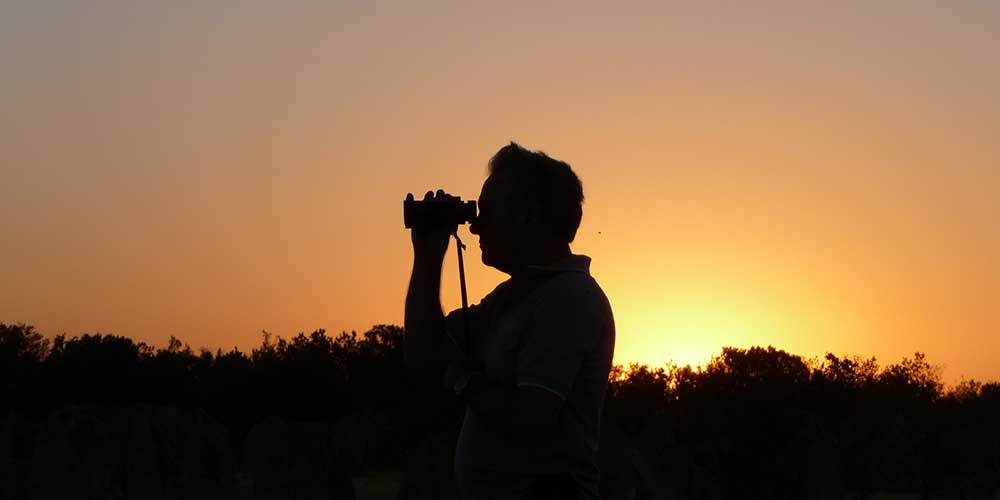
There are a wide range of reasons why you might be nature watching, such as bird watching, hunting or watching safari animals. All of these activities take place in vastly different situations and locations, from rough ridge lines in the New Zealand back country, to dense Kiwi bush, to the plains of Africa, meaning that finding a binocular suitable for every situation can be tricky. Depending on your activity, the weight and size requirements will vary, with hiking, travel and safari binoculars likely needing to be lighter and more compact than binoculars for static bird watching in a hide.
In this guide we’re going to specifically focus on helping you choose binoculars for wildlife viewing in low light situations where the key focus is to have the very best view possible of an animal or bird, and having larger, slightly heavier equipment is a compromise you’re willing to make. We’ll consider the general features of low light binoculars, so you become familiarised with these and provide advice on what’s essential with low light binoculars.
Nature observation is often most successful when animals are at their most active at the beginning or tail end of the day. Unfortunately, as light levels are starting to reduce at dawn and dusk, observing can be hindered as it becomes harder to see. Due to this, your best chances of getting good views are to opt for binoculars that offer bright, clear views, especially in low light situations. In general, this means opting for binoculars with slightly larger lenses such as 50mm that have a magnification on the lower end, somewhere between 8x and 12x at the highest. As with any binoculars, the quality of the optics and the coatings applied to their lenses also have a huge affect on how much you’ll enjoy observing through them. We appreciate that not everyone has a huge budget, so we’ve provided a range of binoculars for wildlife watching in low light in various price brackets.
Best 9 Binoculars for Low Light Nature Watching in 2023
- Vortex Razor UHD 12x50 Binoculars
- Vortex Razor HD 10x50 Binoculars
- Vortex Viper HD 10x50 Binoculars
- Athlon Midas G2 10x50 UHD Binoculars
- Bushnell Engage 10x50 Roof Binoculars
- Vortex Crossfire HD 12x50 Binoculars
- Nikon Action EX 10x50 ATB CF Binoculars
- Bushnell Prime 12x50 Binoculars
- Delta Optical Forest II 8.5x50 Binoculars
Vortex Razor UHD 12x50 Binoculars

Let’s kick things off with the very best low light nature viewing binoculars we have on offer in our range. These incredible binoculars from Vortex are quite simply built with all of the most high quality optical features available. This means that they produced crisp, clear, bright, colour true images, even in low light conditions. They also come with a rather large price tag, but it’s one that seasoned and passionate users won’t mind paying when they see how incredible they are for observation in those critical moments of dawn and dusk. This model has a slightly higher, 12x magnification than some of the other models in our range which means that the exit pupil is also slightly smaller. Although this traditionally reduces low light performance, Vortex use their optical tool box to include a range of other high end features that help to balance this out. This includes Ultra HD glass, an APO colour correction system, fully multicoated optics and phase correction.
Features:
- 12x magnification
- 50mm objective lenses
- Roof prism
- Abbe-Koenig prism
- UHD optical system
- APO colour correction system
- XR™ Fully multi-coated lenses
- Plasma Tech coating
- Phase correction coating
- ArmorTek ® Ultra-hard, scratch-resistant coating
- Waterproof and fogproof
- Rubber armour
- Adjustable eye cups
- Tapered eyecups
- Centre focus wheel
- Diopter adjustments
- Tripod adaptable
- True open hinge design reduces weight
- 17mm eye relief
- 4.2mm exit pupil
- 87m field of view
- 1023g
Pros:
- The very best quality, ultra HD glass
- APO colour correction system is loved by glassers and photographers across the world for producing colour true images
- Higher magnification than some other models for closer up viewing
- Quite a wide field of view despite the higher magnification
- Good eye relief so if you have issues with your eyesight and wear eye glasses, these would be a good option
- Exceptional Vortex warranty
Cons:
- On the heavier side
- Higher magnification reduces the exit pupil so the images may not be as bright as some other models
Vortex Razor HD 10x50 Binoculars

Vortex offer a wide range of different binoculars at different levels of quality. These awesome Razor HD binoculars sit in their mid to high end range of binoculars and are packed with loads of features that help their low light performance. From HD lenses to dielectric prism coatings and phase corrected lenses, Vortex utilise a wide range of quality optical techniques to allow these binoculars to offer exceptional performance in low light conditions. This makes them the ideal tool for nature viewing in low light conditions.
Features:
- 10x magnification
- 50mm objective lenses
- APO system
- HD lens elements
- XR™Plus fully multi-coated premium proprietary coatings
- Dielectric prism coatings
- Plasma Tech coating for durability and performance
- Phase corrected lenses
- Roof prism design
- Open hinge with lightweight magnesium chassis
- ArmorTek scratch-resistant lens coating
- Waterproof and fogproof
- Rubber armour
- Multi-position eyecups
- Centre focus wheel
- Locking diopter
- Tripod adaptable
- 16mm eye relief
- 5mm exit pupil
- 96m field of view
- 796g
Pros:
- HD glass
- Wide range of quality prism coatings applied
- APO lens system allows for the better correction of chromatic and spherical aberration of colour than cheaper lenses making the image more true to life
- As they’re on the lighter end of the weight range for 50mm objective binoculars, they could be a good option for people going on safari who want the best light capturing ability possible and don’t mid that little extra weight
- Exceptional Vortex warranty
Cons:
- Not the widest field of view on offer
Vortex Viper HD 10x50 Binoculars
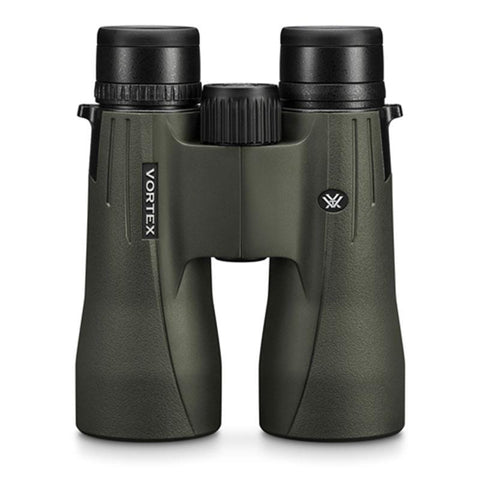
The Vortex Viper HD binoculars offer a perfect balance between high end optics and budget. That means that Vortex have included many of their high quality binocular features, whilst omitting a couple of their top of the line features that push the price much higher. Namely, this means that they have left out the APO lens system and also opted for HD glass rather than UHD glass. This significantly reduces the price of these binoculars making them more accessible to a wider range of users. They’re still in the higher end of the price range but if you’re looking for binoculars for wildlife watching in low light then they’re an exceptional tool to do so.
Features:
- 10x magnification
- 50mm objective lenses
- HD lenses
- XR fully multi-coated lenses increase light transmission
- Multi-layer dielectric prism coatings provide bright, clear, colour-accurate images
- Phase correction coating on roof prism models enhances resolution and contrast
- Roof prism design
- Waterproof, fog proof and nitrogen purged
- ArmorTek ultra-hard, scratch-resistant coating protects exterior lenses from scratches, oil and dirt
- Rubber amour for grip and protection
- Twist up eyecups for comfortable viewing with or without glasses
- Centre focus wheel
- Locking right eye diopter to adjust for your eyes
- Tripod adaptable
- 16mm eye relief
- 5mm exit pupil
- 105m field of view
- 805g
Pros:
- HD glass
- Dielectric and phase corrected for bright, clear, colour true images with high resolution and contrast
- Good eye relief
- Wide field of view
- Good balance better top of the line quality and price
- Quite a light weight model
- Exceptional Vortex warranty
Cons:
- Still got quite a high price tag for many users
Athlon Midas G2 10x50 UHD Binoculars

The Athlon Midas binoculars offer quality that rivals that of the Vortex Razor UHD, but without the price tag. These awesome binoculars offer ultra high definition glass that produces clear and sharp images. Fully multicoated lenses mean that they produce bright, clear images, even in the low light conditions of dawn and dusk. They have a a nice wide field of view and aren’t too heavy for comfortable use. Athlon have only recently arrived on the New Zealand optical market in the last couple of years, but their performance and value for money make them a great option for hunters and nature watchers alike.
Features:
- 10x magnification
- 50mm objective lenses
- UHD glass
- Multi layer ESP Dielectric prism coatings
- Advanced fully multi-coated lenses
- Argon purging gives you better waterproofing and thermal stability
- Phase corrected prisms
- XPL Coating gives you an extra protection on the exterior lenses from dirt, oil and scratches
- Lightweight magnesium chassis
- BaK4 prisms to reflect more light to your eyes
- 16.9mm eye relief
- 5mm exit pupil
- 115m field of view
- 907g
Pros:
- Great price point for the quality they offer
- Good field of view
- UHD lenses for bright and clear views in low light
Cons:
- Slightly heavier than some models but this is marginal
Bushnell Engage 10x50 Roof Binoculars
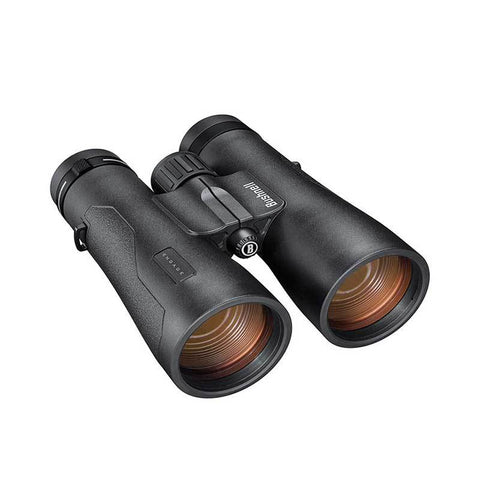
Well loved for their quality and value, Bushnell Engage binoculars have been the go too binocular for many hunters for a long time. And that’s for good reason. Extra low dispersion glass, phase and dielectric coatings make for great low light capabilities. They’re a good weight for their size and have a wide field of view. Bushnells lens barrier coating protects the lenses from the great outdoors.
Features:
- 10x magnification
- 50mm objective lenses
- Water proof and fog proof
- Fully multi coated optics
- Locking diopter
- Prism roof system
- ED glass
- Rubber textured exterior and slip resistant
- EXO Barrier lens coating
- PC3 Phase Coating
- ED glass
- Dielectric coating
- Ultra wide band coating
- 15mm eye relief
- 5mm exit pupil
- 113m field of view
- 830g
Pros:
- Low weight for their size
- HD glass
- Good field of view
- Great price tag for the quality
Cons:
- The eye relief could be a tiny bit longer but really that is a very minimal problem and overall they’re awesome
Vortex Crossfire HD 12x50 Binoculars
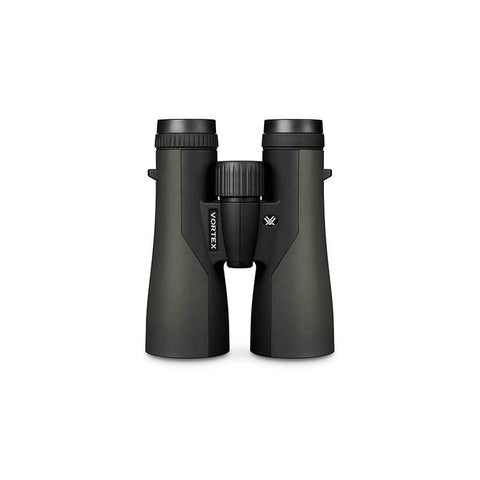
Part of the entry level line of binoculars offered by Vortex, the Crossfire HD’s are a great option for those who want high definition glass but without the high price tag. A great all rounder for lots of different types of observing and the 50mm fully multicoated lenses work well in low light. The field of view is slightly limited by the 12x magnification but it does help get you that little closer to animals and birds of interest.
Features:
- 12x magnification
- 50mm objective lenses
- HD optical system
- Fully multi-coated lenses
- Waterproof
- Rubber armour
- Roof prism
- Adjustable eye cups
- Centre focus wheel
- Diopter adjustments
- Tripod adaptable
- 15mm eye relief
- 4.2mm exit pupil
- 83m field of view
- 836g
Pros:
- HD glass at a great price point
- Durable
- Exceptional Vortex warranty
Cons:
- Field of view could be a bit wider
Nikon Action EX 10x50 ATB CF Binoculars

The Action line from Nikon is one of their entry level models. A waterproof finish sets them aside from their other lower priced models and makes them great for the outdoors and anything action orientated! This porro prism design from Nikon has a wide field of view and a great long eye relief making them a good option for people who wear glasses. They are on the heavier side so may not be ideal for prolonged use.
Features:
- 10x magnification
- 50mm objective lenses
- Eco-glass optics: lead and arsenic-free
- BAK4 porro prisms
- Bright, fully multicoated optics
- Turn-and-slide rubber eyecups
- Rubber armoured housing
- Aspherical eyepiece lens eliminates image distortion
- Includes wide neck strap and carry case
- Includes eyepiece rain guard and push-on objective lens caps
- Waterproof
- 17mm eye relief
- 5mm exit pupil
- 113m field of view
- 1021g
Pros:
- Waterproof
- Wide field of view
- Good eye relief
- Good price
Cons:
- Heavier and bulkier than other models that have a roof prism design
- Standard lenses
Bushnell Prime 12x50 Binoculars
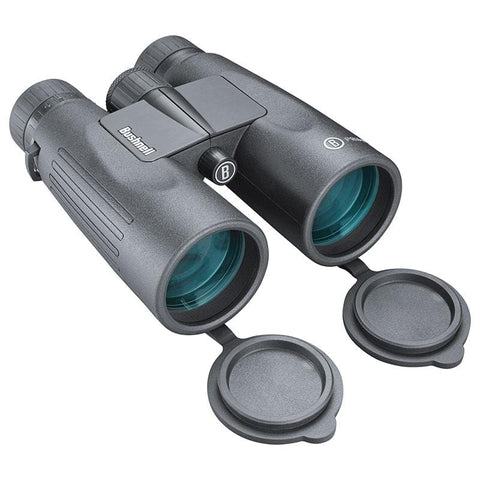
The Bushnell Prime line of optics offers a reliable, decent quality binocular for a good, attainable price. Built with the key features needed for outdoor use, they’re waterproof and have fully multicoated optics for as bright a view possible.
Features:
- 12x magnification
- 50mm objective lenses
- Waterproof
- Full multicoated optics
- BaK 4 glass
- 16mm eye relief
- 4.2mm exit pupil
- 91m field of view
- 950g
Pros:
- Affordable
- Waterproof
- Good eye relief
Cons:
- Could be lighter
- Quite a small field of view
Delta Optical Forest II 8.5x50 Binoculars
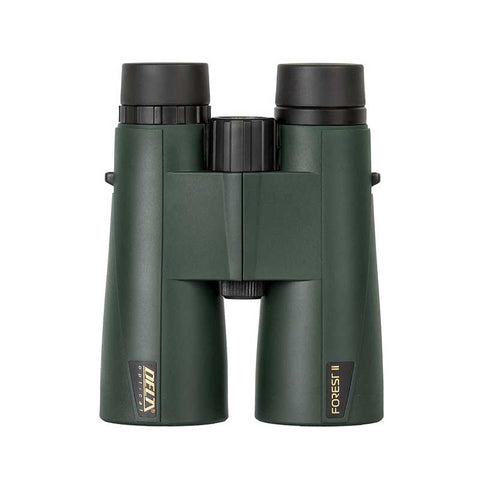
South African optical brand, Delta, offer a relatively unique 8.5x magnification alongside a 50mm objective lens to produce a rather incredible exit pupil of 5.9mm. This allows them to perform really well in low light conditions. Although the lenses aren’t high definition, they are all fully multicoated for the best light transmission possible in their class. A great option for bright images when you don’t need too much magnification.
Features:
- 8.5x magnification
- 50mm objective lens diameter
- BaK-4 roof prisms
- Fully multicoated
- Waterproof
- 22mm eye relief
- 5.9mm exit pupil
- 98m field of view
- 832g
Pros:
- Really good exit pupil measurement for bright images
- Waterproof
- Very good eye relief so a good option if you were glasses
- Lightweight for their size
Cons:
- Only built with standard glass
Key Features to Keep in Mind for Low Light Nature Watching
Choosing binoculars can be a tricky task if you’re not quite sure which features to look for for your specific activity. We hope that our product suggestions above have given you some ideas of the binoculars in our range that will do the best job when it comes to nature watching in lower light conditions. If you’re not taken with any of the options we’ve suggested, then here’s some advice on the key features to look out for when you’re assessing other binoculars on the market.
Magnification
It’s a common misconception that the higher the magnification of a binocular the better. In reality, the better quality the optics and their coatings the better, and the magnification you opt for should vary depending on your activity and conditions. For most nature watching we’d suggest either an 8x, 10x or 12x (if you want to see extra details) magnification will do the trick. It’s important to keep in mind though that higher magnifications always result in a smaller exit pupil which essentially means that they allow less light through to your pupil and result in dimmer images at times like dawn and dusk. With this in mind, we’d suggest opting for binoculars that have either 8x or 10x magnification for low light wildlife viewing. We have also suggested some 12x models, however we’d only advise opting for these if your primary focus will be mainly day time observing in high detail, and if you choose quality models so that the quality of their glass can compensate for the smaller exit pupil.
Objective lens diameter
One of the key factors in determining how well a binocular performs in low light is the size of its objective lens. The objective lens is the lens furthest from your eye. This lens is responsible for collecting light from the environment around you to present a bright image. This means that the larger the objective lens diameter, the better light gathering they have (as long as the magnification isn’t too high). Due to this, all of our suggestions and advice for low light binoculars for nature viewing have a 50mm objective. You could also opt for 56mm objective lenses if you don’t mind the extra weight.
Low light performance
If you’re planning on using a binocular in low light, then a very important factor to consider if how well they will perform in dimmer environments. As discussed above, this mainly comes down to the configuration of magnification and objective lens size and also the lens coatings used on the optics. The best low light binoculars will either have an 8x50, 8x56, 10x50 configuration or, if you want more magnification, you could opt for 12x50 or 12x56 binoculars. Always choose fully multi coated optics. We’ll discuss lens coatings in more detail below.
Lens coating
One key feature that sets aside entry level or average binoculars to those that offer exceptional, high end performance, is the lens coatings used on their lenses and also prisms. The better quality these special coatings are, the brighter, crisper and clearer images will be. In addition, they’ll produce images with colours that are more true to life. Where possible, always opt for binoculars with fully multicoated optics, phase coatings and dielectric coatings too. This will give you the best chance of seeing animals and birds of interest in low light.
Prism type
There are two types of binocular design; porro prism and roof prism. Porro prisms are the more traditional configuration of binoculars. They produce bright, clear images however due to the their design, they’re usually more bulky than the more modern roof prism design. Most the binoculars in our product round up for low light nature viewing binoculars have a roof prism design as this allows them to have a more compact form, even when they feature 50mm objective lenses.
Field of view
The field of view of a binocular refers to how much of the environment or view, that you can see in front of you at one time when you look through the binocular. So, in actual terms, if you were looking at a field through the binocular, how many meters of that field would you be able to see horizontally at one time. Field of view is important in binoculars in situations where you either want to enjoy a view, or you want to scan a landscape to locate something of interest. Imagine standing on a ridge line in New Zealand at dusk and desperately trying to seek out the illusive stag you’ve been tracking for the last two days. Binoculars with a wider field of view will allow you to see more of that ridge line at once than ones with a more restricted field of view. It’s important to remember that magnification has a big affect on field of view size, but construction and quality does two. Two relatively similar looking 10x50 binoculars may have very different field of views, so if you think you’ll need to scan a landscape then always try to opt for the model with a wider field of view if possible.
Weight
Choosing binoculars for low light nature viewing ultimately leads to an exercise in balancing your wants and needs from a binocular. For low light performance you’ll ideally want large lenses, but if you then have to carry those large lensed binoculars around with you for hours on end, you’ll likely add a lot of strain to your neck due to the weight of them. With this in mind we’d usually suggest opting for binoculars with a 50mm or 56mm objective lens for low light viewing. Don’t forget that two very similar looking binoculars can vary a lot in weight depending on their quality of design and construction so always keep a close eye on how heavy they are and opt for the lightest model in your price range and requirements.
Other factors to consider
Now that we’ve considered the main features to look for in nature watching binoculars, we’ll briefly touch on a couple of other things you may want to consider depending on your set activity. If it turns out that you’re not actually hugely bothered about using your binoculars in low light conditions, but would like to be able to use them for much longer range nature watching, then you might want to consider image stabilised binoculars as an option. Or, perhaps you’ve decided that you’d like to combine two pieces of optical equipment in one to keep the weight down on your next hunt? In that case, some rangefinder binoculars would be a great option. Budding nature photographers may also like to check out our range of digiscoping adapters for phones so that you can capture digital memories of the stunning images your new binoculars allow you to see.
Warranty
All of the binoculars in our line are covered by a New Zealand warranty and are sourced from the authorised importer for NZ. Warranties offered on sports optics vary from covering 1 year, through to a limited life time warranty or, in some cases a no questions asked warranty where even accidental damage is covered. The warranty for each of our products is shown on their product information page or you can view them all here. We’d always advise checking this out before purchasing to get the best warranty you can. This means that in the unlikely event that theirs a manufacturing issue with your optics, they’ll be covered.
Where to Buy Nature Watching Binoculars?
At ScopeUout we’re a small, family run, online only business. This means that we don’t have a retail shop where you can try out each of our binocular models. Due to this, we go above and beyond to provide you with as much information about each of our binocular models as we possibly can, and provide as much advice as possible regarding which binoculars will be the best option for specific activities. As far as we’re concerned, the more knowledge you have, the more confident you will feel when you make your decision when purchasing.
In this guide we’ve considered the key features to look for when choosing the best binoculars for nature viewing in low light conditions such as dawn and dusk. This includes the best objective lens size, lens coatings and exit pupil size. We’ve also provided a number of suggestions to suit a range of budgets.
If you’ve read the guide and decided that you’re actually looking for binoculars for wildlife watching in brighter, daylight hours and want to opt for small binoculars to keep the weight down whilst hiking or travelling, then you can check out our guides on how to choose binoculars for those situations here. You can also check out our buying guide for travel, safari or bird watching binoculars too. We’ve also got a handy filter option on our entire binocular line that allows you to filter our large range down by size, weight, activity, waterproofing and more. If you have any questions at all we’re never far away so please get in touch.





Leave a comment